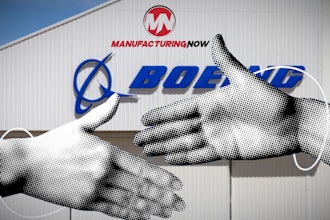Through November 2007, U.S. exports reached $1.48 trillion, according to U.S. Commercial Services, a unit of the International Trade Association that promotes and protects U.S. commercial interests abroad and ensures that U.S. businesses compete successfully in the global marketplace.
Yet, only a small percentage of U.S. businesses actually export. With more than 70 percent of the world’s purchasing power and 95 percent of its population beyond U.S. borders, a U.S. business that is only selling domestically is reaching just a small share of potential customers.
As the global economy becomes more competitive, many companies that do not already have a presence overseas should consider looking into exporting their products to other areas of the world.
There are many resources available to manufacturers to help get them started. To determine if exporting is right for you, ask yourself these questions:
• Is there a demand overseas for your goods?
• Are you looking to expand and diversify your customer base?
• Are you willing to put in the effort and commitment, energy and effort it takes to expand your product overseas?
For new exporters, the U.S. Commercial Services and its Gold Key Program can help answer some of these questions for you, provide market research in your targeted export market and set up meetings overseas with potential buyers and distributors.
Garth McGillewie, Sr., founder of Hydra Platforms, a manufacturer of under bridge aerial access platforms advises fellow U.S. businesses to start with the U.S. Commercial Services, thoroughly research the marketplace they wish to enter and be prepared for its challenges.
“Once you take the first step, you can use the information gained from U.S. Commercial Services to get a better sense of your target market, but it’s also important what you do with this information afterward and how you develop your business relationships overseas,” says McGillewie.
McGillewie’s company exports access platforms to help safely improve infrastructure and build bridges all over the world. His company has been exporting worldwide for the past 10 years and in 2006 received the Presidential “E” Award, the highest honor the federal government can give to an American exporting company for accomplishments in the global market place.
Dan Sharpe, International Sales Manager for American Augers, a manufacturer of underground technology equipment, also advises using U.S. Commercial Services and its Gold Key program. He says, “There are other sources to use, but I would start first with the U.S. Commercial Service as it is the most economical first step.”
Consider your product and whether there is a demand for it overseas. For Dan Sharpe, his product relied on the needs of a country’s economic growth and expanding infrastructure.
“I looked at infrastructure projects and the forecasted expenditures for infrastructure. For example, India has one of the fastest growing economies and infrastructure. Expansion and updating is critical for their growth,” he says.
For most industries, looking to countries with the fastest growth is often the place to introduce your product. However, this can present its own set of challenges. For instance, China, one of the largest markets for exports, is also one of the most difficult countries to successfully export products.
“It took us years to understand Chinese marketplace and format a process that laid out the terms on which we would do business with China — and stand our ground with those terms,” says McGilliwie.
He advises that if you choose to export your product to China, you must have a lot of diligence, be very careful, understand the market, the contract terms, and make sure you are always paid in full before you ship the product.
The greatest challenges in exporting can be the trade disputes, so it is important to make sure your product is inspected before it leaves the port, all balances are paid in full, and thoroughly document all stages of the processes, including the customers’ requirements.
“Always make sure everyone is comfortable with the payment terms,” says Sharpe. He also advises that you research as much as possible about the country in which you plan to do business.
“It helps to be familiar and respectful of a country’s customs and businesses practices,” he points out. “By doing so, you can make it a win/win situation.”
Once you understand all aspects of exporting to a specific market, its culture and how they do business, you may start to see your business grow in that market.
“Exporting has increased our business by 35 percent — and international business is critical to our long term growth,” says Sharpe.
For McGilliwie, about 20 percent of his sales are from exports and he continues to see more potential as countries look to expand their economy and improve their infrastructure.
In fact, according to Curt Cultice, Senior Communications Specialist, U.S. Commercial Services, there is no better time to export.
“Free trade agreements, together with ease of transportation, the Internet, and U.S. Government programs and partnerships continue to simplify the export process,” says Cultice.
And while exporting does offer a lot of challenges, it still has its benefits to the economy and your business. For instance, U.S. exports support millions of American jobs.
“In 2005, 5.7 million jobs were linked to manufactured exports,” says Cultice.
In addition, exporting can help keep your business afloat when markets in other areas are flat.
“If the economy in any sector is weak, exporting allows you to have a much larger market to balance out and maintain production. Being able to export and compete in the world market is an enormous benefit to almost any company,” McGillewie points out.
Despite the benefits, smaller U.S. companies are often intimidated by exporting because it is much more complicated than shipping domestically.
“Many smaller businesses are so busy running their day-to-day operations that they don’t consider their export potential. Oftentimes, companies think exporting is too burdensome, believe it’s just for larger firms, or are not aware of the services offered by U.S. Government agencies such as the Commercial Service,” says Cultice.
Entering export markets worldwide can take a lot of energy and effort, but with the proper resources manufacturers can understand and overcome the shipping, cultural and business differences, and make exporting a very good investment for any company.
For further information on U.S. Commercial Services and its Gold Key Program, visit http://trade.gov/cs/


















